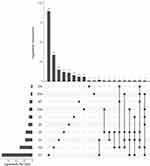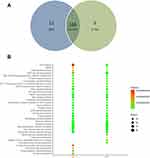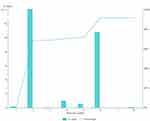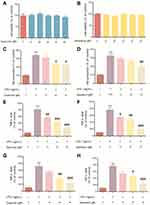Back to Journals » Drug Design, Development and Therapy » Volume 16
Decoding the Key Functional Combined Components Group and Uncovering the Molecular Mechanism of Longdan Xiegan Decoction in Treating Uveitis
Authors Zheng YX, Wang KX, Chen SJ, Liao MX, Chen YP, Guan DG, Wu J, Xiong K
Received 23 August 2022
Accepted for publication 9 November 2022
Published 17 November 2022 Volume 2022:16 Pages 3991—4011
DOI https://doi.org/10.2147/DDDT.S385136
Checked for plagiarism Yes
Review by Single anonymous peer review
Peer reviewer comments 2
Editor who approved publication: Prof. Dr. Tin Wui Wong
Yi-Xu Zheng,1 Ke-Xin Wang,2– 4 Si-Jin Chen,5 Mu-Xi Liao,6 Yu-Peng Chen,3,4 Dao-Gang Guan,3,4 Jing Wu,7 Ke Xiong1
1Department of Ophthalmology, Nanfang Hospital, Southern Medical University, Guangzhou, People’s Republic of China; 2Neurosurgery Center, Guangdong Provincial Key Laboratory on Brain Function Repair and Regeneration, Department of Cerebrovascular Surgery, Engineering Technology Research Center of Education Ministry of China on Diagnosis and Treatment of Cerebrovascular Disease, Zhujiang Hospital, Southern Medical University, Guangzhou, People’s Republic of China; 3Department of Biochemistry and Molecular Biology, School of Basic Medical Sciences, Southern Medical University, Guangzhou, People’s Republic of China; 4Guangdong Province Key Laboratory of Single Cell Technology and Application, Southern Medical University, Guangzhou, People’s Republic of China; 5Department of Medical Imaging Center, Nanfang Hospital, Southern Medical University, Guangzhou, People’s Republic of China; 6The First Affiliated Hospital of Guangzhou University of Chinese Medicine, Guangzhou, 510405, People’s Republic of China; 7Huiqiao Medical Center, Nanfang Hospital, Southern Medical University, Guangzhou, People’s Republic of China
Correspondence: Jing Wu; Ke Xiong, Email [email protected]; [email protected]
Objective: Longdan Xiegan Decoction (LXD) is a famous herbal formula in China. It has been proved that LXD has been shown to have a significant inhibitory effect on suppresses the inflammatory cells associated with uveitis. However, the key functional combination of component groups and their possible mechanisms remain unclear.
Methods: The community detecting model of the network, the functional response space, and reverse prediction model were utilized to decode the key components group (KCG) and possible mechanism of LXD in treating uveitis. Finally, MTT assay, NO assay and ELISA assay were applied to verify the effectiveness of KCG and the accuracy of our strategy.
Results: In the components-targets-pathogenic genes-disease (CTP) network, a combination of Huffman coding and random walk algorithm was used and eight foundational acting communities (FACs) were discovered with important functional significance. Verification has shown that FACs can represent the corresponding C-T network for treating uveitis. A novel node importance calculation method was designed to construct the functional response space and pick out 349 effective proteins. A total of 54 components were screened and defined as KCG. The pathway enrichment results showed that KCG and their targets enriched signal pathways of IL-17, Toll-like receptor, and T cell receptor played an important role in the pathogenesis of uveitis. Furthermore, experimental verification results showed that important KCG quercetin and sitosterol markedly inhibited the production of nitric oxide and significantly regulated the level of TNF-α and IFN-γ in Lipopolysaccharide-induced RAW264.7 cells.
Discussion: In this research, we decoded the potential mechanism of the multi-components-genes-pathways of LXD’s pharmacological action mode against uveitis based on an integrated pharmacology approach. The results provided a new perspective for the future studies of the anti-uveitis mechanism of traditional Chinese medicine.
Keywords: traditional Chinese medicine, TCM, uveitis, foundational acting communities, FACs, mechanisms, network analysis
Introduction
Uveitis belongs to inflammatory disease that concern retinal vessels, retina, choroid, vitreous body, ciliary body, and iris,1 which has a potential risk of blindness. According to the epidemiological survey in the United States and Europe, uveitis has an annual incidence of 20–50 million, and the prevalence rate is about 100–150 million.1 Blindness caused by uveitis accounts for about 10% of all blind patients.2,3 Therefore, uveitis not only significantly affects the quality of life of patients but also places a heavy burden on the family and society.
Since the pathogenesis of uveitis is still unclear, it often brings a lot of confusion to clinical treatment. In the western medicine treatment of uveitis, pupil dilators, non-steroidal anti-inflammatory drugs, glucocorticoids, and immunosuppressants can be used comprehensively based on etiological treatment. However, increasing evidence indicated that TCM is widely used to treat inflammation-induced complex diseases, including uveitis. There are many different prescriptions that can be used to treat uveitis4, such as Shaoyao Gancao Decoction, Longdan Xiegan Decoction (LXD), and Qufeng Huoxue pill. Among them, LXD5–9 has been widely used in TCM clinical trials, with anti-inflammatory, liver protection, and immunomodulatory effects, and has been found to successfully control uveitis in TCM clinic. Previous studies of pharmacology have shown that LXD can effectively alleviate the clinical manifestations of experimental autoimmune uveitis in rats, reduce the differentiation power of uveal-derived CD4+ T cells, and inhibit the expression level of Th1 and Th17 landmark cytokines IFN-γ and IL-17, which is consistent with some conclusions obtained in the following experimental parts.10 In addition, LXD can also promote the secretion of IL-10 and restore immune balance, thus accelerating the recovery of autoimmune uveitis, suggesting that LXD may treat uveitis by regulating the immune response. In addition, histopathological studies showed that LXD had protective effects on the iris, ciliary body, retina, and other tissues of EAU rats.11 However, LXD, as a traditional Chinese medicine compound, has complex components, and its main components and molecular mechanism for treating uveitis are still unclear, which need to be further explored.
LXD is composed of 10 kinds of Chinese herbal medicine: Gentiana scabra Bunge [Gentianaceae] (Longdancao,6g), Scutellaria baicalensis Georgi [Labiatae] (Huangqin,9g), Gardenia jasminoides J. Ellis [Rubiaceae] (Zhizi,9g), Bupleurum chinensie DC. [Umbelliferae] (Chaihu,10g), Alisma plantago-aquatica subsp. orientale (Sam.) Sam. [Alismataceae] (Zexie,12g), Plantago asiatica L. [Plantaginaceae] (Cheqianzi,9g), Rehmannia glutinosa (Gaertn.) DC. [Scrophulariaceae] (Dihuang, 20g), Angelica sinensis (Oliv.) Diels [Umbelliferae] (Danggui,8g), Glycyrrhiza uralensis Fisch. ex DC. [Leguminosae] (Gancao,6g), Akebia quinata (Thunb. ex Houtt.) Decne. [Lardizabalaceae] (Mutong,9g). Its traditional formula is recorded in the Chinese Pharmacopoeia. However, there is no literature to clarify the molecular mechanism of LXD. Therefore, how establishing a new method to detect the key components of LXD prescription on uveitis and speculate its hidden mechanisms not only provides a useful treatment strategy for the accurate treatment of uveitis but also contributes to the understanding of the interaction between drugs and the body and guiding the discovery of new drugs.
The compound prescription of TCM has many flavors and ingredients, which makes it have the characteristics of “multi-target, multi-pathway and multi-link”. In addition, the characteristics of TCM research mainly include a holistic view, dialectical treatment, prescription use and so on, so the network analysis research arises at a historic moment, and it defeats many previous systematic pharmacological models to crack TCM and TCM prescription models. It is precisely because it has the characteristics of integrity, systematicness and considering interaction.
Currently, integrated system pharmacology has been extensively employed in treating various kinds of disorders. For example, Gao and so on12 decipher the potential mechanism of turmeric formula in the treatment of cardiovascular disease by using integrated pharmacology; Bao et al13 revealed the potential mechanism of anti-osteoporosis of Xianlinggubao capsule through network analysis. Yang et al14 developed an integrated system pharmacology model to discover the effective components and essential targets of Shengdihuang decoction in treating dysfunctional uterine bleeding. Following the in-depth convergence of bioinformatics, integrated pharmacology and system biology, and the continual accumulation and improvement of data accuracy based on the robust computational methods15–19, reliability and completeness, the research ideas and techniques of integrated systems pharmacology would be widely applied to the study of key components group and mechanisms of action of TCM prescriptions, providing more methodological innovations for molecular level research of TCM.
The prescriptions of TCM are widely employed in treating complex disorders in the clinic. Due to the complexity, however, there is still lack systematic methods to decipher the main underlying synergistic mechanism of the prescription. In this study, a integrated system pharmacological model was designed to decipher the potential mechanism of LXD in the therapy of uveitis, so as to provide methodological reference for the treatment of complex diseases with TCM.
In this research, for decoding the key functional combined components group and uncovering the molecular mechanism of LXD in treating uveitis, the integrated optimization strategy by using a combination of Huffman coding and random walk algorithm and node importance calculation method to capture the key components group (KCG) in the treatment of uveitis with LXD. Firstly, an active ingredients-targets-pathogenic genes-disease network was construct to obtain FACs by using our published community detection algorithm and FACs was validated by pathogenic genes coverage, functional pathways coverage and key nodes contribution. Secondly, the novel designed node importance calculation method was performed to explain the key response space and effective proteins in FACs, and KCG was detected from key response space based on CCR model. Finally, the potential mechanism of LXD on uveitis was inferred by functional analysis and experiment in vitro was performed to confirm the reliability of KCG (Figure 1). This study provides a new network-based approach for the evaluation and selection of appropriate treatment strategies for complex diseases of TCM.
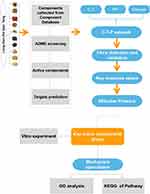 |
Figure 1 The diagram of our proposed network pharmacological strategy. LXD stands for Longdan Xiegan decoction and FACs stands for foundational acting communities. |
Materials and Methods
ADME Screening and Active Component Identification
All chemical components of LXD used in this study were extracted from Traditional Chinese Medicine System (TCMSP, http://lsp.nwsuaf.edu.cn/tcmsp.php),20 but not all chemical components have good medicinal properties. Therefore, we use published ADME model21 to screen chemical components with better medicinal properties, and the screening criteria are mainly as follows: The five rules of Lipinski, Oral bioavailability (OB, %F) ≥ 30% and Drug-like (DL) ≥ 0.14.22 The Lipinski’s rule of 5 refers to: The MW (molecular weight) of the component is not more than 500 Daltons, the number of hydrogen bond donors, hydrogen bond receptors and rotatable bonds in the compound do not exceed 5, 10, and 10, respectively. In the structure of the compound, the logP which means the logarithmic value of the compound is ranged from −2 to 5. Oral bioavailability is a reflection of the ratio of the number of drugs given into the human circulation, which describes the percentage of the number of drugs in the blood that are absorbed by the gastrointestinal tract and passed through the liver to reach the systemic circulation.23 Drug-like property refers to the feature that an ideal drug should have a suitable physical and chemical traits of successful drugs.24 After screening by ADME, we obtained potential active ingredients of LXD, but some ingredients did not meet these rules. However, experiments proved that they had high concentration and strong biological activity, so we also retained these ingredients as active ingredients, with a total of 35.
Networks Construction
Cytoscape software was used to build the CTP network of LXD prescription.25 We use Cytoscape plugin NetworkAnalyzer to analyze the topology parameters of the network.26
Detection of FACs and Effective Space
FACs (foundational acting communities) of LXD in treating uveitis were figured out based on CTP network by utilizing our previous mathematical algorithm with slight modification.27
The effective space was established as follows:
Med, Min, Max represents median, minimum and maximum of nodes importance, respectively;
 represents the number of the shortest path between nodes v and t, is the number of the shortest path passing through node s.
represents the number of the shortest path between nodes v and t, is the number of the shortest path passing through node s.
x, v represents nodes (genes)
 represents the shortest distance (minimum number of edges) when x and v are connected.
represents the shortest distance (minimum number of edges) when x and v are connected.
Cumulative Contribution Rate of FACs in CTP Network
The contribution weight (CM) represents the net contribution of FACs in LXD. The R value is employed to indicate the influence of components through the following methods:
Where dc is the degree of each component, which is calculated by Cytoscape. R is a monitor of the influence of components. Where n stands for the number of components in the LXD FACs; m is the number of components in the LXD CT network; Ri stands for the indicator of each component in the LXD FACs, and Rj stands for the indicator of each component in the LXD CT network.
Develop CCR Model to Select KCG
The KCG is hidden in the components of the key response space. We define the network coverage of each component j in the key response space as wj. The contribution rate of targeted to pathogenic genes is vj. The maximum expected network coverage rate of KCG is R. In these variables, R > 0, wj > 0, vj > 0, 1 ≤ j ≤ n, KCG is required to be found from n components, so that the cumulative contribution rate of targeted to pathogenic genes is the largest. The specific calculation formula is as follows:
Kyoto Encyclopedia of Gene and Genome Pathway
In order to perform functions of FACs, signal pathways for enrichment analysis were collected from the KEGG database.28 The P value was set to less than 0.05. Analysis results were visualized by Pathview.29
Experimental Validation
Reagents
The reagents in this study are described in the Supplementary Materials.
Cell Culture and Treatment
Cell culture and processing as described in the Supplementary Material.
Cell Viability Assay
Cell viability was determined as described in the Supplementary Material.
Measurement of NO
Referring to our previous method,27 10–30 μM quercetin and sitosterol were used to perform NO measure.
Measurement of TNF-α and IFN-γ
The level of TNF-α and IFN-γ were detected by utilizing the assay kits according to specifications.
Statistical Analysis
SPSS 22.0 was used for statistical analysis. The significance of divergences in multiple comparisons was calculated using one-way ANOVA. Obtained p-values were corrected by Benjamini-Hochberg false discovery rate (FDR). The p-value < 0.05 was considered statistically significant.
Results
Chemical Analysis
Chemical identification is important for studying the effective parts, effective components and mechanism of action of Chinese herbal medicine. Through a literature search, the high concentration and bio-active components of LXD were kept. Table 1 lists the chemical composition of Chinese herbal medicine and the concentration of the identified components, which supply experimental assistant biochemical space for searching for active components.
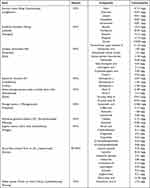 |
Table 1 Experimental Chemical Information of Herbs in LXD Based on Published Literature |
Active Components in LXD
By searching the TCMSP database, a total of 1278 components of 10 kinds of Chinese herbal medicine in LXD were obtained. TCM formulations usually contain a series of ingredients, and ADME screening method is usually used to screen the active components. After ADME screening, 195 active components in LXD passed the comprehensive screening criteria (Table S1 in Supplemental Material). In order to further analyze these active components, it can be seen from Figure 2 that 10 active components in LXD are common to two or more Chinese herbal medicines.
Construction of Weighted Gene Regulatory Network of Uveitis
The pathogenesis of uveitis is the result of a weighted multi-gene regulation. Constructing and interpreting this weighted gene regulation network is the key step for us to understand the pathogenesis of uveitis and provide an intervention strategy. In the first step, we use BioGRID (https://thebiogrid.org/) and STRING (https://cn.string-db.org/) database to build PPI network. We obtained 995 pathogenic genes with correlation scores from Genecards (https://www.genecards.org/). The higher confidence pathogenic genes were defined as the genes whose relevant score was larger than the median of the correlation scores of all pathogenic genes. Then, the 767 higher confidence pathogenic genes with relevant scores were mapped to PPI network to build a weighted gene regulatory network. The weighted gene regulatory network contained 704 nodes and 36,636 edges (Figure 3). The genes whose correlation scores were more than 100 included CDH1, APC, BRCA2, MLH1 et al. Although there is no direct evidence of the association between the above genes and uveitis, studies have shown that mice with CDH1 deletion are more likely to develop prostatic inflammation and chronic uterine inflammation.30,31 The expression of MLH1 is significantly increased in chronic gastritis caused by Helicobacter pylori.32 These results show that the weighted gene regulation network and the ranked weighted genes can reflect the pathogenesis of uveitis and provide a reliable reference for the next construction of the CTP network.
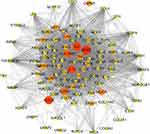 |
Figure 3 Weighted pathogenic genes regulatory network. Nodes size represents the weight of pathogenic genes, different colors represent different scores of nodes. |
CTP Network Construction
In order to analyze the relationship between active components and their responding targets in LXD formula, a component-target network was constructed by using Cytoscape. The consequences show that the LXD network consists of 195 active components, 905 target proteins and 8754 interactions. The topology parameters of these CT networks are further analyzed by NetworkAnalyzer, and it is found that the average degrees of components and targets of LXD are 44.82 and 9.68, respectively. These results mean that one target can be regulated by multiple components and each component can target multiple genes. Furthermore, we map the disease-weighted gene regulatory network and component target network to PPI network to obtain CTP network. The CTP network contains 5525 nodes and 126,687 edges.
FACs Predication and Validation
FACs Predication
CTP network is a complex network containing target genes and pathogenic genes. How to obtain the key drug effect module in this network is the basis of understanding the mechanism of LXD in treating uveitis. In this study, we integrated random walk and Huffman encoding information mapping algorithm into our integrated system pharmacological model. The algorithm finds 8 FACs with significant functional significance in CTP network through heuristic optimization (Table S2 in Supplemental Material and Figure 4).
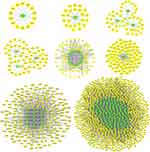 |
Figure 4 Predicted FACs of LXD in CTP network. The green node represents the specific components of the LXD, and the yellow node represents the related targets. |
FACs Validation
To verify whether the predicted FACs in LXD could stand for the corresponding C-T network for the treatment of uveitis. Several methods were employed to validate the reliability and accuracy of FACs. The first method is to calculate the ratio of the number of pathogenic genes contained in FACs to the number of pathogenic genes in CTP network, and the higher the ratio, it indicates that FACs can retain pathogenic genes in CTP network to the maximum extent. The second method is to investigate the ratio of gene enrichment pathway in FACs and CTP network. The third method is to calculate the cumulative contribution rate of important nodes in FACs to the cumulative contribution rate of nodes in the CTP network. A high percentage implies that FACs can retain significant nodes in the corresponding CTP network. The specific results are as follows:
Compared the Number of Pathogenic Genes in FACs and CTP Network
To evaluate whether the number of uveitis pathogenic genes in FACs is close to that in the corresponding CTP network. The acknowledged pathogenic genes of uveitis were collected from the published literature for further analysis. Results showed that the CTP network of LXD contains 20 pathogenic genes. The FACs of LXD contain 19 pathogenic genes. Compared with CTP network of LXD, the ratio of pathogenic genes in FACs reached 95%, confirming the predicted FACs with higher pathogenic gene coverage (Figure 5). These results show that FACs has highly consistent with the CTP network in the number of pathogenic genes, and also confirm that our developed FACs prediction model is reliable and accurate.
 |
Figure 5 The number of overlapped pathogenic genes between CTP network and FACs in LXD (A–C). (A–C) use the Venn diagram to visualize the overlap number between CTP network and FACs in LXD. |
Validated the Genes Enriched Pathways in FACs and CTP Network
Another indicator of the representation and influence of predicted communities is their functional coherence, which can be obtained through the related gene enrich pathways.33 In this study, we use this strategy to determine whether the FACs discovered in LXD can represent its complete CTP network at the functional level. Our analysis shows that the gene enrichment pathway of FACs in LXD accounts for 91.2% of the gene enrichment pathway of LXD CTP network (Figure 6). The gene enrichment pathway involved in the FACs of LXD is highly consistent with that of its CTP network. This result confirmed that FACs and CTP network have a high degree at the functional level, and once again validated the reliability and accuracy of our FACs detection model.
Validated the Important Nodes in FACs and CTP Network
The importance of nodes in network is one of the crucial topological parameters to characterize the influence of nodes in the network.27 We evaluate the importance of nodes in FACs and CTP network by using our published mathematical model. Based on the results of the calculation, an R value is assigned to the FACs. The details are shown in Figure 7. The sum of 8 FACs reaches 92.19% cumulative contribution rate of that in CTP network. The results show that our model can get the most important topological structure in CTP network.
Effective Proteins Selection and Validation from Key Response Space
Drug action is the initial interaction between drugs and body cells, and its process involves the interaction between a variety of proteins and even genes, which is more complex. The occurrence and development of various diseases often involve the transcription and translation of genes and the interaction of a variety of proteins, which form a complex network that has not been completely cracked so far. The intervention effect of drugs is often shown as the effective components of drugs acting on single or multiple nodes of the network, thus promoting the therapeutic effect throughout the whole network. The importance of nodes is an important factor to be considered in optimizing the network. At present, the main methods to describe the importance of nodes are degree, intermediate number, neighborhood connectivity, shortest path et al. These methods mainly depended on the nature of a certain aspect of the network to depict the importance of nodes in the network. In this study, we design a new network importance calculation method based on key functional communities, which takes into account the influence and near centrality of nodes. We identify 349 Effective Proteins from key functional communities.
In order to verify the functional accuracy and reliability of our method of finding Effective Proteins by node importance based on key functional communities, and compared with other methods, we analyzed the enrichment of LXD target genes and pathogenic genes in KEGG and Gene Ontology (GO), respectively, and took the intersection of the two as the main intervention in KEGG and GO. Based on our method, the KEGG analysis and GO analysis of 349 effective proteins accounted for 97.73% and 93.67% of the intervention KEGG and GO analysis, respectively (Figure 8C). Based on the relatively common calculation methods of node importance, including degree, intermediate number and neighborhood connectivity, the Effective Proteins are obtained, respectively. The Effective Proteins obtained by this method were analyzed by GO and KEGG pathway enrichment analysis and then compared with the intervention approach and intervention GO. The consequences (Figure 8A and B) show that the percentage of Effective Proteins enrichment pathways (Figure 8D) found in intervention pathways and intervention GO items in our model is markedly higher than that in the degree model, intermediate centrality model and neighborhood connectivity model. These results show that our model has higher accuracy and better functional coverage than other node importance models. The above results confirm the accuracy and reliability of our method of finding Effective Proteins by node importance based on key functional communities and further prove that the selected effective protein plays an important part in the pathogenesis of uveitis.
Key Component Group Selection and Validation
Establishing CCR model to optimize key response space to get key component groups, ultimately to explaining the molecular mechanism of LXD in treating uveitis. According to the results of cumulative contribution, the components which rank in the top 10 include LXD3 (Sudan III), LXD4 (Ent-epicatechin; ent-Epicatechin), LXD5 (baicalein; wogonin), LXD20 (sitosterol; sitosterol), LXD45 (sophorin; acacetin), LXD77 (baicalin flavone; Panicolin), LXD90), LXD156 (glycerol; Glycyrin), LXD182 (stigmasterol; Stigmasterol), LXD185 (epberberine; epiberberine) can contribute 55.87% of the effective target coverage. For further analysis, 47 components can contribute 90.26%. 54 components can contribute 95.42% of the effective protein target coverage, so we selected 54 components as key component group (Table S3 in Supplemental Material and Figure 9). The higher target coverage of effective proteins, the higher evidence that key component group may be dominant and have a combined effect in the treatment of uveitis.
 |
Figure 9 Accumulative contribution rate score of active components in LXD. |
In order to analyze the role of LXD in the therapy of uveitis at the functional level, we analyzed the pathway using Key component group targets and uveitis pathogenic genes, respectively. There were 171 enrichment pathways of core components (p < 0.05) and 116 enrichment pathways of pathogenic genes (p < 0.05). The Key component group target enrichment pathway accounts for 77.58% of the pathogenic gene enrichment pathway. These main targets are usually enriched in PI3K-Akt signal pathway (Hsa04151), Ras signal pathway (Hsa04014), MAPK signal pathway (Hsa04010), Rap1 signal pathway (Hsa04015), Sphingolipid signal pathway (Hsa04071), cAMP signal pathway (Has04024) and so on. For example, PI3K and Akt play a key role in HLA-B27-associated acute anterior uveitis, which is closely related to the anti-inflammatory protection of endotoxin tolerance.34 Activation of P38 mitogen-activated protein kinase (MAPK) can mediate IL-17 (+) uveal T cell response and aggravate ocular inflammation associated with uveitis.35 The discovery of angiotensin converting enzyme 2 (ACE2) promotes the establishment of Ras-ACE2/Ang-(1-7)/Mas protective axis. Studies have shown that increasing the expression of ACE2 can alleviate the ocular inflammatory reaction of experimental autoimmune uveitis mice by regulating the ocular immune response, including the differentiation of Th1/Th17 cells and the polarization of M1/M2 macrophages.36
Some sphingomyelin metabolites, especially ceramides, act as bioactive messengers to trigger and regulate inflammation and inflammatory diseases. Based on this, the increase of total phospholipids has been found in retina of EIU (endotoxin-induced uveitis) rats. The study on the mechanism of protective lipids and pro-inflammatory lipids will become a useful treatment for EIU inflammation.37 CAMP (cyclic adenosine monophosphate) is an important intracellular substance involved in regulating substance metabolism and biological function and is the “second messenger” of life information transmission. It has been found that increasing the intracellular cAMP level of iTregs before transplantation can improve the therapeutic effect of iTregs on established EAU (experimental autoimmune uveitis).38 The results show that the strategy of combining the key reaction network with CCR model to optimize the formulas of TCM is reliable, and the predicted KCG may play a therapeutic role by mediating T cell proliferation, differentiation and cytokines secreted.
Analysis of Potential Mechanism of LXD in the Treatment of Uveitis
Uveitis is a disease closely related to autoimmunity and inflammation, which is often mediated by Th17 cells (IL-23/IL-17) and/or Th1 cells and their cytokines. In the above analysis, we found that there are 116 pathways shared by CACG and pathogenic genes, including several signal pathways of IL-17 (Hsa04657), Toll-like receptor (Hsa04620) and T cell receptor (Hsa05166). More and more evidences showed that these pathways may relate to the pathogenesis or therapeutic targets of uveitis.35,39,40 In order to explore the therapeutic mechanism of LXD on a systematic level, we constructed an integrated signaling pathway using three molecular pathways (Figure 10). In order to determine the specific position where LXD acts on the signal pathway, we regard the first three columns as the upstream of the pathway and the other columns as the downstream positions of the pathway. Among them, IL-17 signal pathway (Hsa04657) is one of the preferred ways for LXD to treat uveitis. LXD regulates 25 targets such as IL-17RA, IL-17RB, IL-17RC and IL-17RE upstream of IL-17 signal pathway (Hsa04657) and 34 downstream targets such as IL-6, TNF- α and MMP3. Most of the targets (Hsa04620) of LXD regulating Toll-like receptor signal pathway are located downstream of this pathway, such as PKA, AKT and RAF-1. In addition, it (Figure 10) shows that LXD can also affect the activation of T cell receptor signals to play a vital role in treating uveitis. Therefore, LXD plays therapeutic role in uveitis by regulating ER-AKT/ERK key cascades, synergistically affecting cell cycle and promoting apoptosis.
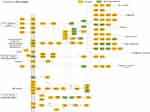 |
Figure 10 Enrichment pathway diagram of FACs in LXD for uveitis. |
Experimental Validation of Important KCG in vitro
MTT assay was used to detect the effects of quercetin and sitosterol on RAW264.7 cell viability. Quercetin and sitosterol had no effects on RAW264.7 cell viabilities at 10, 20, 30, 40, and 50 mM compared with the control group (Figure 11A and B). Therefore, three concentrations (10, 20, and 30 mM) were used in subsequent experiments.
NO is a modulator of intercellular information transmission and has the powerful function of mediating inflammatory reactions and cellular immunity. To evaluate the results obtained from the network analysis model further, key ingredients in the KNMSs of each formulation have opted for experimental validation. Quercetin and sitosterol from LXD were used to detect the potential anti-inflammatory effects of LPS-induced RAW264.7 cells. In contrast to the control group, NO level in lPS-treated cells was significantly increased by 310.90%, while quercetin (20 and 30 mM) decreased extracellular NO level by 77.41% and 86.26%, sitosterol (10 and 20 mM) significantly decreased extracellular NO level by 78.43% and 121.84%, respectively, in a concentration-dependent manner (Figure 11C and D). Our results showed that quercetin and sitosterol inhibited lipopolysaccharide induced nitric oxide production in RAW264.7 cells. Our results showed that quercetin and sitosterol inhibited the production of nitric oxide in Lipopolysaccharide-induced RAW264.7 cells.
ELISA kits were used to assay effect of quercetin and sitosterol on pro-inflammatory cytokine (TNF-α and IFN-γ) levels. Normally, RAW264.7 cells produce small amounts of pro-inflammatory cytokines. When they were stimulated by LPS, the levels of IFN-γ and TNF-α were significantly higher by 896.24% and 639.40% in quercetin’s effects, while they were markedly increased by 764.86% and 802.52% in sitosterol’s effects, compared to the control group. However, after pretreatment with 10, 20 and 30 μM, quercetin reduced TNF-α levels by 278.19%, 445.19%, 625.42%, IFN-γ levels by 117.36%, 283.76%, 501.63%, respectively (Figure 11E and G), while sitosterol reduced TNF-α levels by 274.77%, 228.82%, 518.46%, and reduced the levels of IFN-γ by 267.70%, 500.00%, 467.70%, respectively (Figure 11F and H). Yin et al10 used animal experiments to verify that LXD can inhibit the expression levels of IFN-γ and IL-17, the landmark cytokines of Th1 and Th17, and effectively alleviate the clinical manifestations of experimental autoimmune uveitis in rats. In our experiment, we found that the level of IFN-γ decreased under the action of quercetin or sitosterol, a specific component of LXD, which is consistent with the experimental results of Yin.
Discussion
At present, the efficacy of synthetic drugs in the treatment of uveitis is not ideal, and most of them have adverse reactions.41 In China, the clinical application of some classical prescriptions in the treatment of uveitis has a long history and remarkable curative effect. However, from a molecular point of view, the TCM formula usually play therapeutic roles via multi-components, multi-targets and the multi-pathways.42–44 Thus, decoding the inherent attribute of complex ingredients and their unclear targets of TCM prescriptions has become an urgent problem to be solved.
With the rapid development of bioinformatics, the network analysis of TCM has become a booming field of modern research of TCM in recent years.12,45–47 Therefore, the use of this method, combined with rich TCM treatment experience, is expected to crack the internal mechanism of TCM prescriptions for complex diseases. Online pharmacology methods can help us search for potentially active ingredients and targets on the basis of a wide range of databases, and visually display the network of drug targets.48 The interaction between drugs and targets is abstracted as a network, and then the influence of drugs on the biological network where targets are located can be studied as a whole. This research strategy can help us to incisively understand the underlying mechanism of TCM in the systematic context of interaction. However, the mode of drugs on the biological network still exists redundancy and noise in the integrated systems pharmacology research.27
In order to address this issue, we introduce an information map method, which integrated random walk rules and Huffman coding theory. The algorithm can heuristically optimize the discovery of communities in CTP networks. The optimized FACs results were used to uncover the mechanism of LXD in treating uveitis. In this process, the contribution coefficient model is applied to verify the predicted FACs, and the accuracy and reliability of the proposed strategy are verified.
After ADME screening, a total of 195 active components of LXD prescription were found. For example, β-sitosterol is common in four Chinese herbal medicines, DG, MT, ZZ, and HQ, which can down-regulate the levels of IL-1 β, IL-6, and TNF- α and improve inflammatory reaction. Kaempferol shared by LD, ZZ, CH, and GC can regulate the secretion of cytokines and reduce the expression of inflammatory proteins, and its anti-inflammatory mechanism may be concerned with the inhibition of the activation of the NF-κB pathway. In addition, it was also found that quercitrin shared by CH and GC had anti-inflammatory effects, and its anti-inflammatory molecular mechanism may be related to the inhibition of TNF-α, NO, iNOS and COX-2 production. In addition to the common components, most Chinese herbal medicines have their own unique components, such as isoglycyrrhizin, a specific component of GC, which down-regulates the expression of inflammatory factors such as TNF-α, IL-6 and IL-4 by inhibiting NF-κB and MAPK signaling pathways; aristolochic acid A, a specific component of SDH, may catalyze the release of arachidonic acid by directly blocking phosphate A2 (PLA2), which has certain anti-inflammatory activity.
In order to analyze the core component group and mechanism of the prescription of uveitis, we used the target prediction tool to predict the targets of the active components in LXD, and constructed the CTP network. The degree distribution of the CTP network confirmed that the same component can target to different genes, and multiple components can also band to the same target, which fully reflects the complexity of multi-components and multi-targets of TCM in the treatment of complex disorders. After constructing the CTP network, we found that the genes and components with a larger degree may have the important role in therapy and intervention. For example, as a common and safe dietary ingredient, quercetin has the potential anti-inflammatory ability. Intraperitoneal injection of quercetin significantly reduced inflammation in the S-antigen-induced uveitis rat model.49 The experimental results show that 4β→8)-ent-epicatechin has an immunomodulatory effect and is expected to join the research and development of new immunotherapeutic agents.50 Glabridin exerts its anti-inflammatory effect by inhibiting the production of cytokines, inhibiting the activity of cyclooxygenase (COX), down-regulating the level of NO, inhibiting the activation of cyclic guanosine monophosphate (cGMP) and activating BKCa channel.51 NODS, IL-6, HLA-B27 and IL2RA are all component targets with a high nodal degree. Blau syndrome,52 an autoimmune inflammatory disease that can cause uveitis, has been proved to be secondary to a single amino acid NODS mutation with a large nodal degree. In recent years, targeted therapy for IL-6 pathway is being extended to immuno-inflammatory diseases, including uveitis.53 HLA-B27 and IL2RA genes are closely associated with acute anterior uveitis and intermediate uveitis, respectively,54,55 with the development of genetic engineering, more effective treatments for uveitis will emerge in the near future.
Biological events mainly refer to uncertain biological interaction events, and many uncertain events together constitute a complex biological regulation network. For a long time, we have been exploring new methods to crack the network structure and its key components, resulting in some new concepts such as probabilistic network community, which has been proved to provide an effective and manageable way to quickly characterize the main functional units of disease progression.56 Therefore, it is particularly important to identify motifs in biological networks, including the key steps to determine overlapping and non-overlapping topics.57 Shi et al pointed out that revealing the community structure of complex networks can help us better understand how networks work.58 8 FACs in the CTP network were predicted by using network communities prediction model. Coverage of disease-causing genes, cumulative contribution of key nodes and coverage of functional pathways were used to validate the accuracy and reliability of FACs. The verification results show that the cumulative contribution rate of FACs in the number of pathogenic genes, the number of gene enrichment pathways and important nodes are highly consistent with CTP network. This shows that our FACs detection model can maximize the consistency of pathogenic genes, functional pathways and network topology in formulas of TCM.
KEGG enrichment analysis of all FACs in LXD showed that the prescription could treat uveitis through IL-17 signal pathway, T cell receptor signal pathway and Toll-like receptor signal pathway. Among these pathways, IL-17 signal pathway involves in the early inflammation of uveitis. IL-17 promotes the production of other inflammatory cytokines and participates in the recruitment of neutrophils, monocytes and Th1 cells, which together with other inflammatory cytokines induce inflammation. The increase of serum IL-17 level in patients with uveitis can be used as a marker of disease activity.59 Toll-like receptor (TLR), which is the most important pattern recognition receptor in the innate immune system, can recognize pathogen-related molecular patterns of microorganisms. Basic and clinical studies have shown that TLRs are involved in the pathogenesis of uveitis, and are considered a promising target for the treatment of visual threat uveitis.60
T-cell-mediated uveitis has been widely recognized. It has been found that a new anti-mouse CD3ε antibody Dow2 can recognize mouse CD3ε and inhibit T-cell-mediated inflammation in uveitis model. This antibody is expected to protect patients with uveitis from severe eye inflammation.
In order to find the key functional response space and effective proteins in FACs, we fully consider the connectivity and central control power of these FACs network nodes, and give them new node importance calculation scores. The nodes whose importance scores are larger than the median scores of all nodes in the network are reserved as key response space, and the protein is called effective protein. This method can remove noise to the maximum extent. The follow-up functional analysis also proved that the accuracy of our node importance calculation method is about 5% higher than that of the traditional node calculation method, which further proves the accuracy of the method of constructing functional response space.
According to the pathway enrichment analysis results of the above effective proteins, they are often involved in PI3K-Akt signal pathway (hsa04151), MAPK signal pathway (hsa04010), Ras signal pathway (hsa04014) and T cell receptor signal pathway (hsa04660) (Figure 8D). Hoekzema et al found that endotoxin tolerance induced by continuous low-dose injection of endotoxin can effectively reduce the degree of uveitis in rats, and P13K-Akt signaling pathway plays an important part in regulating the expression of cytokines induced by endotoxin. Gene expression microarray analysis suggests that differentially expressed genes P13K and Akt may play a key role in the pathogenesis of acute anterior uveitis.61,62 Jing et al proved that inhibition of MAPK signal pathway can effectively reduce local inflammation in (EAU) rats with experimental autoimmune uveoretinitis; Huang et al confirmed that inhibition of MAPK signal pathway mediates anti-inflammatory effect in mouse uveitis model experiment.63–65 Renin-angiotensin system (Ras) is an important hormonal system regulating cardiovascular function, which is related to a variety of autoimmune diseases. The established protective axis of Ras (ACE2/Ang- (1–7)/Mas) is becoming a new target for reducing ocular inflammation.36 Autoimmune or non-infective uveitis is an intraocular inflammation that affects the neuroretina and threatens vision. It is driven by strong T cells, but the exact pathogenesis of (Microbiome and Autoimmune uveitis) is not fully understood.39
In order to obtain the components that act on these key effective proteins, we designed CCR model, which can quickly find the key component groups from the functional response space. For further functional analysis, the key components in the key response space of the prescription were also analyzed and verified. The results suggest that baicalin (Baicalin), the key component of LXD, may affect the treatment of uveitis by indirectly acting on T cell receptor signal pathway. Studies have shown that baicalin has an immunomodulatory effect by activating aromatics receptors, regulating Treg/Teff balance and CD4+T cell proliferation, thus improving experimental autoimmune uveitis.66 Additionally, we will conduct in vivo studies in the future to validate the accuracy and reliability of our proposed integrated system pharmacology model.
Compared with other published work, integrated system pharmacology strategy based on a combination of Huffman coding and random walk algorithm and node importance calculation method, KCG prediction and validation strategy. This study is a computational mining work based on network pharmacology data, which provides a feasible scheme to reduce the verification scale for the experiment. Our proposed integrated prediction and verification strategy provide a methodological reference for optimizing the core component group and explaining the molecular mechanism of TCM in treating complex diseases.
However, there still exist some unsolved issues in this research. Firstly, more components should be selected from the key response space to validate the accuracy and reliability of our proposed integrative approach. Secondly, the precise mechanisms decoded by our model need further validation, for example, the enrichment pathway of key component group targets we obtained needs further pharmacology experiments in vitro and in vivo. Finally, the undirected network used in this research miss the activation or inhibition effects of the targets.
Abbreviations
LXD, Longdan Xiegan Decoction; TCM, Traditional Chinese Medicine; FACs, Foundational Acting Communities; TCMSP, Traditional Chinese Medicine System; OB, Oral bioavailability; DL, Drug-like; PPI, Protein–protein interaction; IL-17, Interleukin-17; MMP3, Matrix metalloproteinase-3; Ras, Renin-angiotensin system; MAPK, Mitogen-activated protein kinase; EIU, Endotoxin-induced uveitis; CAMP, Cyclic adenosine monophosphate; EAU, Experimental autoimmune uveitis; TLR, Toll-like receptor.
Data Sharing Statement
All datasets generated for this study are included in the article/Supplementary Material.
Funding
This study is financially supported by the Science and Technology Planning Project of Guangdong Province (No.2017A020211005) and the President Funding of Nanfang Hospital (No.2019B023 & 2019Z017).
Disclosure
The authors declare that the research was conducted in the absence of any commercial or financial relationships that could be construed as a potential conflict of interest. Yi-Xu Zheng and Ke-Xin Wang are co-first authors.
References
1. Krishna U, Ajanaku D, Denniston AK, Gkika T. Uveitis: a sight-threatening disease which can impact all systems. Postgrad Med J. 2017;93(1106):766–773. doi:10.1136/postgradmedj-2017-134891
2. Abraham A, Nicholson L, Dick A, Rice C, Atan D. Intermediate uveitis associated with MS: diagnosis, clinical features, pathogenic mechanisms, and recommendations for management. Neurol Neuroimmunol Neuroinflamm. 2021;8(1):e909. doi:10.1212/nxi.0000000000000909
3. Miserocchi E, Fogliato G, Modorati G, Bandello F. Review on the worldwide epidemiology of uveitis. Eur J Ophthalmol. 2013;23(5):705–717. doi:10.5301/ejo.5000278
4. Gao JM, Lyu M, Xie WW, Liu XY, Zhao BC, Zhu Y. Zhong Yi Yao Xin Nao Xue Guan Ji Bing Tong Zhi De Fang Ji Yong Yao Gui Lv Fen Xi [Regularity of traditional Chinese medicine prescriptions for same treatment for cardiovascular and cerebrovascular diseases]. Zhongguo Zhong Yao Za Zhi. 2019;44(1):193–198. Chinese. doi:10.19540/j.cnki.cjcmm.20181101.007
5. Kuang GY. Clinical observation on acute anterior uveitis treated by combination of traditional Chinese and Western medicine. Emerg Tradit Chin med. 2006;15(07):726–727. doi:10.3969/j.issn.1004-745X.2006.07.029
6. Ning ZC, Chen XH. Research progress of traditional Chinese Medicine in the treatment of iridocyclitis. Hebei Tradit Chin med. 2020;42(01):151–155. doi:10.3969/j.issn.1002-2619.2020.01.033
7. Pang CS. Experience in the treatment of anterior uveitis. Chin J Tradit Chin Med Opthalmol. 2004;14(03):52–53. doi:10.3969/j.issn.1002-4379.2004.03.027
8. Xu DM. Treatment of 29 cases of uveitis with combination of traditional Chinese and western medicine. Emerg Tradit Chin med. 2010;19(04):687. doi:10.3969/j.issn.1004-745X.2010.04.097
9. Yang XH. Professor Lu Mianmian’s experience in the treatment of uveitis. Fujian Tradit Chin Med. 2012;43(02):
10. Yin X, Qiu Y, Li Z, et al. Longdan Xiegan Decoction alleviates experimental autoimmune uveitis in rats by inhibiting Notch signaling pathway activation and Th17 cell differentiation. Biomed Pharmacother. 2021;136:111291. doi:10.1016/j.biopha.2021.111291
11. Tang K, Guo D, Zhang L, et al. Immunomodulatory effects of Longdan Xiegan Tang on CD4+/CD8+ T cells and associated inflammatory cytokines in rats with experimental autoimmune uveitis. Mol Med Rep. 2016;14(3):2746–2754. doi:10.3892/mmr.2016.5558
12. Gao Y, Wang KX, Wang P, et al. A novel network pharmacology strategy to decode mechanism of lang chuang wan in treating systemic lupus erythematosus. Front Pharmacol. 2020;11:512877. doi:10.3389/fphar.2020.512877
13. Bao H, Guo H, Feng Z, Li X. Deciphering the underlying mechanism of Xianlinggubao capsule against osteoporosis by network pharmacology. BMC Complement Med Ther. 2020;20(1):208. doi:10.1186/s12906-020-03007-1
14. Yang H, Fan Y, Cheng J, et al. Network pharmacology-based prediction of active ingredients and potential targets of ShengDiHuang decoction for treatment of dysfunctional uterine bleeding. Evid Based Complement Alternat Med. 2020;2020:7370304. doi:10.1155/2020/7370304
15. Bhardwaj VK, Oakley A, Purohit R. Mechanistic behavior and subtle key events during DNA clamp opening and closing in T4 bacteriophage. Int J Biol Macromol. 2022;208:11–19. doi:10.1016/j.ijbiomac.2022.03.021
16. Bhardwaj VK, Purohit R. A lesson for the maestro of the replication fork: targeting the protein-binding interface of proliferating cell nuclear antigen for anticancer therapy. J Cell Biochem. 2022;123(6):1091–1102. doi:10.1002/jcb.30265
17. Kumar S, Bhardwaj VK, Singh R, Das P, Purohit R. Identification of acridinedione scaffolds as potential inhibitor of DENV-2 C protein: an in silico strategy to combat dengue. J Cell Biochem. 2022;123(5):935–946. doi:10.1002/jcb.30237
18. Singh R, Bhardwaj VK, Das P, Purohit R. Identification of 11β-HSD1 inhibitors through enhanced sampling methods. Chem Commun. 2022a;58(32):5005–5008. doi:10.1039/d1cc06894f
19. Singh R, Bhardwaj VK, Purohit R. Computational targeting of allosteric site of MEK1 by quinoline-based molecules. Cell Biochem Funct. 2022;40(5):481–490. doi:10.1002/cbf.3709
20. Ru J, Li P, Wang J, et al. TCMSP: a database of systems pharmacology for drug discovery from herbal medicines. J Cheminform. 2014;6:13. doi:10.1186/1758-2946-6-13
21. Shou WZ. Current status and future directions of high-throughput ADME screening in drug discovery. J Pharm Anal. 2020;10(3):201–208. doi:10.1016/j.jpha.2020.05.004
22. Wang C, Ren Q, Chen XT, et al. System pharmacology-based strategy to decode the synergistic mechanism of Zhi-zhu Wan for functional dyspepsia. Front Pharmacol. 2018;9:841. doi:10.3389/fphar.2018.00841
23. Xu X, Zhang W, Huang C, et al. A novel chemometric method for the prediction of human oral bioavailability. Int J Mol Sci. 2012;13(6):6964–6982. doi:10.3390/ijms13066964
24. Tao W, Xu X, Wang X, et al. Network pharmacology-based prediction of the active ingredients and potential targets of Chinese herbal Radix Curcumae formula for application to cardiovascular disease. J Ethnopharmacol. 2013;145(1):1–10. doi:10.1016/j.jep.2012.09.051
25. Demchak B, Hull T, Reich M, et al. Cytoscape: the network visualization tool for GenomeSpace workflows. F1000Res. 2014;3:151. doi:10.12688/f1000research.4492.2
26. Batt G, Besson B, Ciron PE, et al. Genetic network analyzer: a tool for the qualitative modeling and simulation of bacterial regulatory networks. Methods Mol Biol. 2012;804:439–462. doi:10.1007/978-1-61779-361-5_22
27. Wang KX, Gao Y, Lu C, et al. Uncovering the complexity mechanism of different formulas treatment for rheumatoid arthritis based on a novel network pharmacology model. Front Pharmacol. 2020;11:1035. doi:10.3389/fphar.2020.01035
28. Kanehisa M, Sato Y, Kawashima M, Furumichi M, Tanabe M. KEGG as a reference resource for gene and protein annotation. Nucleic Acids Res. 2016;44(D1):D457–462. doi:10.1093/nar/gkv1070
29. Luo W, Pant G, Bhavnasi YK, Blanchard SG
30. Pascal LE, Mizoguchi S, Chen W, et al. Prostate-specific deletion of Cdh1 induces murine prostatic inflammation and bladder overactivity. Endocrinology. 2020. doi:10.1210/endocr/bqaa212
31. Stodden GR, Lindberg ME, King ML, et al. Loss of Cdh1 and Trp53 in the uterus induces chronic inflammation with modification of tumor microenvironment. Oncogene. 2015;34(19):2471–2482. doi:10.1038/onc.2014.193
32. Bartchewsky W
33. Kanehisa M, Furumichi M, Tanabe M, Sato Y, Morishima K. KEGG: new perspectives on genomes, pathways, diseases and drugs. Nucleic Acids Res. 2017;45(D1):D353–d361. doi:10.1093/nar/gkw1092
34. Zhang N, Yu S, Liu X, Lu H. Low dose of lipopolysaccharide pretreatment preventing subsequent endotoxin-induced uveitis is associated with PI3K/AKT pathway. J Immunol Res. 2017;(2017:1273940. doi:10.1155/2017/1273940
35. Wei R, Dong L, Xiao Q, Sun D, Li X, Nian H. Engagement of Toll-like receptor 2 enhances interleukin (IL)-17(+) autoreactive T cell responses via p38 mitogen-activated protein kinase signalling in dendritic cells. Clin Exp Immunol. 2014;178(2):353–363. doi:10.1111/cei.12405
36. Qiu Y, Tao L, Zheng S, et al. AAV8-mediated angiotensin-converting enzyme 2 gene delivery prevents experimental autoimmune uveitis by regulating MAPK, NF-κB and STAT3 pathways. Sci Rep. 2016;6(1):31912. doi:10.1038/srep31912
37. Wang HY, Wang Y, Zhang Y, Wang J, Xiong SY, Sun Q. Crosslink between lipids and acute uveitis: a lipidomic analysis. Int J Ophthalmol. 2018;11(5):736–746. doi:10.18240/ijo.2018.05.05
38. Su W, Chen X, Zhu W, et al. The cAMP-adenosine feedback loop maintains the suppressive function of regulatory T cells. J Immunol. 2019;203(6):1436–1446. doi:10.4049/jimmunol.1801306
39. Horai R, Caspi RR. Microbiome and Autoimmune uveitis. Front Immunol. 2019;10:232. doi:10.3389/fimmu.2019.00232
40. Zhong Z, Su G, Kijlstra A, Yang P. Activation of the interleukin-23/interleukin-17 signalling pathway in autoinflammatory and autoimmune uveitis. Prog Retin Eye Res. 2020;80:100866. doi:10.1016/j.preteyeres.2020.100866
41. Urruticoechea-Arana A, Cobo-Ibáñez T, Villaverde-García V, et al. Efficacy and safety of biological therapy compared to synthetic immunomodulatory drugs or placebo in the treatment of Behçet’s disease associated uveitis: a systematic review. Rheumatol Int. 2019;39(1):47–58. doi:10.1007/s00296-018-4193-z
42. Li DH, Su YF, Sun CX, Fan HF, Gao WJ. A network pharmacology-based identification study on the mechanism of Xiao-Xu-Ming decoction for cerebral ischemic stroke. Evid Based Complement Alternat Med. 2020;2020:2507074. doi:10.1155/2020/2507074
43. Liu Y, Liu Q, Yin C, et al. Uncovering hidden mechanisms of different prescriptions treatment for osteoporosis via novel bioinformatics model and experiment validation. Front Cell Dev Biol. 2022;10:831894. doi:10.3389/fcell.2022.831894
44. Wu J, Wang K, Liu Q, et al. An integrative pharmacology model for decoding the underlying therapeutic mechanisms of ermiao powder for rheumatoid arthritis. Front Pharmacol. 2022;13:801350. doi:10.3389/fphar.2022.801350
45. He R, Ou S, Chen S, Ding S. Network pharmacology-based study on the molecular biological mechanism of action for compound kushen injection in anti-cancer effect. Med Sci Monit. 2020;26:e918520. doi:10.12659/msm.918520
46. Yang L, Fan L, Wang K, et al. Analysis of molecular mechanism of erxian decoction in treating osteoporosis based on formula optimization model. Oxid Med Cell Longev. 2021;2021:6641838. doi:10.1155/2021/6641838
47. Zhang Y, Bai M, Zhang B, et al. Uncovering pharmacological mechanisms of Wu-tou decoction acting on rheumatoid arthritis through systems approaches: drug-target prediction, network analysis and experimental validation. Sci Rep. 2015;5(1):9463. doi:10.1038/srep09463
48. Sun J, Liu J, Liu D, Wu X. Network pharmacology-based and clinically relevant prediction of the potential targets of Chinese herbs in ovarian cancer patients. Biomed Res Int. 2020;(2020:8965459. doi:10.1155/2020/8965459
49. Romero J, Marak, Jr. GE
50. Liu Y, Wang C, Dong X, Cheng D, Zhou T. Immunomodulatory effects of epicatechin-(2β→O→7, 4β→8)-ent-epicatechin isolated from Rhododendron spiciferum in vitro. Immunopharmacol Immunotoxicol. 2015;37(6):527–534. doi:10.3109/08923973.2015.1107574
51. Parlar A, Arslan SO, Çam SA. Glabridin alleviates inflammation and nociception in rodents by activating BK(Ca) channels and reducing NO levels. Biol Pharm Bull. 2020;43(5):884–897. doi:10.1248/bpb.b20-00038
52. Parackova Z, Bloomfield M, Vrabcova P, et al. Mutual alteration of NOD2-associated Blau syndrome and IFNγR1 deficiency. J Clin Immunol. 2020;40(1):165–178. doi:10.1007/s10875-019-00720-6
53. Choy EH, De Benedetti F, Takeuchi T, Hashizume M, John MR, Kishimoto T. Translating IL-6 biology into effective treatments. Nat Rev Rheumatol. 2020;16(6):335–345. doi:10.1038/s41584-020-0419-z
54. D’Ambrosio EM, La Cava M, Tortorella P, Gharbiya M, Campanella M, Iannetti L. Clinical features and complications of the HLA-B27-associated acute anterior uveitis: a metanalysis. Semin Ophthalmol. 2017;32(6):689–701. doi:10.3109/08820538.2016.1170158
55. Lindner E, Weger M, Ardjomand N, Renner W, El-Shabrawi Y. Associations of independent IL2RA gene variants with intermediate uveitis. PLoS One. 2015;10(7):e0130737. doi:10.1371/journal.pone.0130737
56. Ren Y, Ay A, Kahveci T. Shortest path counting in probabilistic biological networks. BMC Bioinform. 2018;19(1):465. doi:10.1186/s12859-018-2480-z
57. Ren Y, Sarkar A, Kahveci T. ProMotE: an efficient algorithm for counting independent motifs in uncertain network topologies. BMC Bioinform. 2018;19(1):242. doi:10.1186/s12859-018-2236-9
58. Xiang J, Li HJ, Bu Z, et al. Critical analysis of (Quasi-)Surprise for community detection in complex networks. Sci Rep. 2018;8(1):14459. doi:10.1038/s41598-018-32582-0
59. Jadideslam G, Kahroba H, Ansarin K, et al. Interleukin-17 mRNA expression and serum levels in Behçet’s disease. Cytokine. 2020;127:154994. doi:10.1016/j.cyto.2020.154994
60. Chang JH, McCluskey PJ, Wakefield D. Recent advances in Toll-like receptors and anterior uveitis. Clin Exp Ophthalmol. 2012;40(8):821–828. doi:10.1111/j.1442-9071.2012.02797.x
61. Booth JW, Telio D, Liao EH, et al. Phosphatidylinositol 3-kinases in carcinoembryonic antigen-related cellular adhesion molecule-mediated internalization of Neisseria gonorrhoeae. J Biol Chem. 2003;278(16):14037–14045. doi:10.1074/jbc.M211879200
62. Hoekzema R, Murray PI, van Haren MA, Helle M, Kijlstra A. Analysis of interleukin-6 in endotoxin-induced uveitis. Invest Ophthalmol Vis Sci. 1991;32(1):88–95.
63. Huang XT, Wang B, Zhang WH, Peng MQ, Lin D. Total glucosides of paeony suppresses experimental autoimmune uveitis in association with inhibition of Th1 and Th2 cell function in mice. Int J Immunopathol Pharmacol. 2018;32:394632017751547. doi:10.1177/0394632017751547
64. Jing C, Sun Z, Xie X, et al. Network pharmacology-based identification of the key mechanism of Qinghuo Rougan Formula acting on uveitis. Biomed Pharmacother. 2019;120:109381. doi:10.1016/j.biopha.2019.109381
65. Wang J, Zhang N, Yu S, Liu XL, Lu H. Effects of endotoxin tolerance on inflammation degree of endotoxin-induced uveitis and PI3K/AKT signaling pathway in iris ciliary body. Ophthalmology. 2020;29(01):50–54. doi:10.13281/j.cnki.issn.1004-4469.2020.01.010
66. Zhu W, Chen X, Yu J, et al. Baicalin modulates the Treg/Teff balance to alleviate uveitis by activating the aryl hydrocarbon receptor. Biochem Pharmacol. 2018;154:18–27. doi:10.1016/j.bcp.2018.04.006
 © 2022 The Author(s). This work is published and licensed by Dove Medical Press Limited. The full terms of this license are available at https://www.dovepress.com/terms.php and incorporate the Creative Commons Attribution - Non Commercial (unported, v3.0) License.
By accessing the work you hereby accept the Terms. Non-commercial uses of the work are permitted without any further permission from Dove Medical Press Limited, provided the work is properly attributed. For permission for commercial use of this work, please see paragraphs 4.2 and 5 of our Terms.
© 2022 The Author(s). This work is published and licensed by Dove Medical Press Limited. The full terms of this license are available at https://www.dovepress.com/terms.php and incorporate the Creative Commons Attribution - Non Commercial (unported, v3.0) License.
By accessing the work you hereby accept the Terms. Non-commercial uses of the work are permitted without any further permission from Dove Medical Press Limited, provided the work is properly attributed. For permission for commercial use of this work, please see paragraphs 4.2 and 5 of our Terms.






